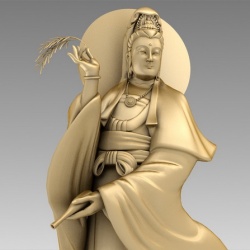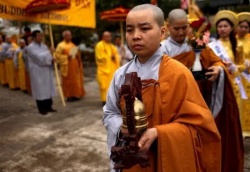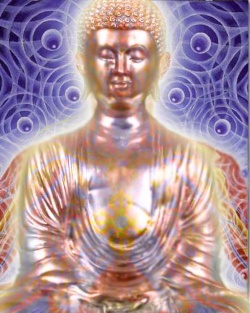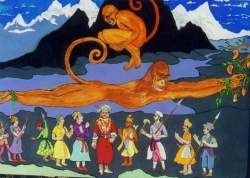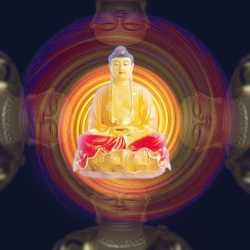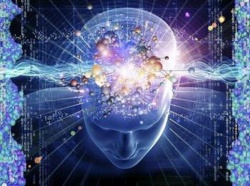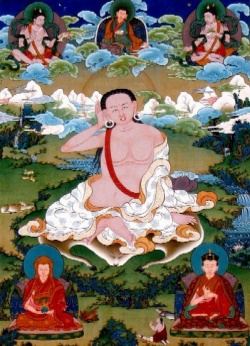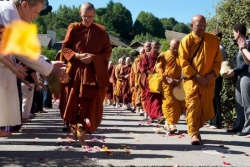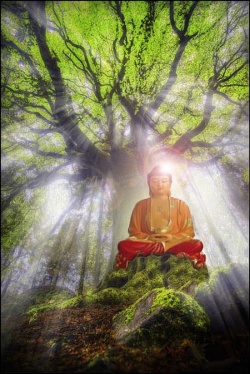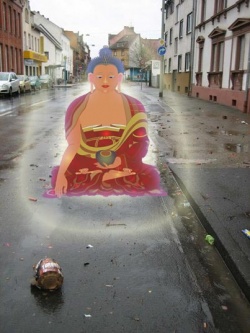The Phenomenology of the Path
BY ALEXANDER DUNCAN
The Buddha distinguished four fundamental degrees of spiritual accomplishment: stream-entry, once-returning, non-returning, and arahantship. To these he added the practices leading to the realization of these fruits, a clear reference to kamma and its effects.
The stream is a metaphor the Buddha used for both the Supermundane Eightfold Path and sangsara. The implication is that there is a relation or correlation between the four realizations and the eight steps of the path. Nevertheless, the exact relationship is subtle.
Stream-entry is, as the word suggests, the attainment of the path itself. As such, it is the fundamental attainment. The stream-enterer (sotāpanna) is one who, having attained the path, has overcome the fetters of belief in the reality of the self,
skepticism, and attachment to rites and rituals. Expressed in positive terms, he has achieved selflessness, certainty, and non-attachment to actions. Such a person has achieved the dhamma-eye (dhammachakkhu).
The stream-enterer has achieved a “taste” of nibbana that results in a decisive awakening. This realization is called the “breakthrough to the dhamma” (dhammābhisamaya). This state is identical with the state of the hearer (sawaka), the ariyasangha (spiritual community), and Perfect View (sammaditthi).
A stream-enterer cannot be reborn as an animal, ghost, or demon (I prefer the term “demon” to hell being because hell is a Judaeo-Christian concept that has no correspondence in Buddhism, being permanent, but neither term is ideal).
According to the tradition, a stream-enterer must attain full, final, and complete enlightenment within no more than seven rebirths. However, like the statement that nibbana can be achieved in as short a time as seven days, whereas the Pali Canon provides evidence of rebirth in a
shorter time than this, there does not appear to be an objective basis for this specific number. Why not six or eight rebirths? Perhaps there is an explanation somewhere, but I do not know of it. Thus, I take it figuratively rather than literally, i.e., in a relatively short time, depending on the nature and intensity of the karmic residue.
Concerning this accomplishment, the Buddha said, taking up a bit of soil under his fingernail, “for a noble disciple, a person accomplished in view who has made the breakthrough, the suffering that has been destroyed and eliminated is more, while what remains is trifling. The latter
does not amount to a hundredth part, or a thousandth part, or a hundred thousandth part of the former mass of suffering that has been destroyed and eliminated, since there is a maximum of seven more lives. Of such great benefit … is the breakthrough to the Dhamma, of such great benefit is it to obtain the vision of the Dhamma.”
The term “breakthrough” may be compared with Padmasambhava’s concept of the “leap.” It implies that the attainment of stream-entry is a singular, momentary, even visionary experience. It is not clear whether the experience itself destroys kamma, or is itself the result of the destruction of kamma. As we have already discussed, a stream-enterer is not necessarily a monastic or even celibate. Therefore, the
ariyasangha is not identical with the monastic sangha, as pointed out by Dr. Peter Masefield. The four factors for attaining stream-entry consist of associating with superior persons, hearing the true dhamma, careful attention, and practising the dhamma. A stream-enterer experiences an instantaneous transformation of being, an awakening characterized by directly knowing and seeing the truth.
The second developmental accomplishment is that of once-returner (ekabījin or sakadāgāmin). In addition to the three fetters already mentioned, he has significantly, but not completely, weakened craving and anger. As the name implies, the once-returner must suffer only one more human rebirth. He will either be reborn as a dewa or attain nibbana. One can also attain this stage without embracing celibacy. Thus, this stage is available to a householder.
The third developmental accomplishment is that of non-returner (anāgāmin). The non-returner has completely overcome all the foregoing fetters. In addition to the previous attainments, he has achieved indifference to sensual pleasures and perfect benevolence or compassion. Anagamins are never reborn as human beings. They are reborn directly in one of the Five Pure Abodes of the Form World. From there they attain full enlightenment.
By definition, therefore, neither a bodhisatta nor a future Buddha has ever achieved this stage, because, had they done so, they could never be reborn as a human being. Therefore, the conclusion is that these four stages of development are not, strictly speaking, sequential, or even necessary. Clearly, one can skip a step. I am not sure whether this fact has ever been noted, but it follows logically nevertheless. Because the
fetter of craving is completely overcome, a non-returner must be celibate. Still, he is not necessarily a monastic. The suttas represent this stage as an ideal stage for the laity to aspire toward. The attainment of the stage of non-returner is equivalent to the attainment of the first jhana.
Finally, the fourth developmental accomplishment is that of arahant. The arahant has overcome all of the previous fetters plus five additional fetters, viz., craving for rebirth in any state, the ego-conceit, restlessness or agitation, and, finally, ignorance, the root of the chain of cause and effect. Thus, the arahant adds complete detachment, selflessness, peace, and wisdom to the accomplishments of the previous stages.
According to tradition, a householder cannot remain in the state of arahantship. Either he will attain arahantship at death or he will become a monastic immediately upon achieving arahantship. Strictly speaking, therefore, all arahants are monastics, at least after the fact. This is not true of the previous stages. Thus, the common identification of the ariyasangha with monasticism represents a conceptual confusion.
The arahant has also perfected the five faculties of faith, energy, mindfulness, concentration, and wisdom. According to the Buddha, an arahant is incapable of nine actions: killing, stealing, sex, lying, sensuality, and wrong actions based on desire, hatred, delusion, and fear. Even if powerful sensory experiences come into his range of perception, they will not perturb his mind.
One can see there is a kind of correspondence between these four stages and the Supermundane Eightfold Path. The stream-enterer has attained Perfect View. All the stages have attained some step of the Path. However, beyond that a simple one-to-one correspondence is difficult to show. The ten fetters have no direct correspondence with the Eightfold Path. However, the faculties of energy, mindfulness, and concentration, mastered by the arahant, suggest the final three steps of the Supermundane Path, viz., Perfect Effort, Perfect Mindfulness,
and Perfect Concentration. Wisdom is the specific attainment of the first step of the path, viz., Perfect View or, in other views, the goal. An arahant has perfected all these. The Buddha says these five faculties are implicit in all the stages, but to different degrees. In the outsider or worldling, the puthujjana, they are completely absent. However, this begs the question of the nature of the attainment of the stream-winner, who has achieved Perfect View, overcome skepticism, and attained certainty in the truth of the dhamma.
Two stages that precede the stage of stream-winner consist of dhamma followers and faith followers. The former is higher than the latter. Dharma and faith followers are stages of intermediate development between an ordinary worldling and a stream-winner. They consist of ordinary wisdom and faith in the Buddha respectively. The Buddha says dhamma followers will attain enlightenment after an unspecified
number of rebirths. Presumably, this number is greater than seven. The faith follower will be reborn as a dewa in a higher world. Both will attain stream-entry in their current life. Presumably, in order to distinguish the faith follower form the once-returner and the non-returner, the faith follower will only attain enlightenment after at least two additional rebirths.
The wanderer Vacchagotta wonders whether the Buddha is the only one who has attained to these states. The Buddha assures him others in the community have also attained. He includes both male and female monastics, who have attained the highest stage of arahantship; celibate male and female lay followers, who have attained the third stage of non-returning; and non-celibate male and female lay followers, who have attained the first and second stages of stream-entry and once-returning. Thus, the
Buddha makes no spiritual distinction between the genders. However, he does say non-celibate practitioners cannot proceed beyond the second stage of once-returning, for the very practical karmic reason that the non-celibate person is still attached to sensual desire and rebirth. Nevertheless, once-returning is still a very advanced state of spiritual development.
A bodhisatta or future Buddha cannot attain any of these states, since they all imply non-rebirth as a human being at some point in the future. The Buddha says he has been reborn many times as a Bodhisatta over countless eons. One sees that the path of the arahant is not the only possible path, but only one possible path.
Seven Kinds of Person
According to another classification, the Buddha recognizes seven kinds of persons: the two-ways-liberated person, the wisdom-liberated person, the body-witness, one who has attained-to-view, the faith-liberated person, the dhamma follower, and the faith follower. We have already discussed the concepts of liberation by wisdom and faith as well as the dhamma and faith followers. We
have also discussed tranquility meditation (samatha) and insight meditation (vipassana). Samatha means literally “quietude of the heart.” Vipassana means “intuition.”
The practice of samatha results in the pacification of the physical body by means of the form and formless meditations, the eight jhanas. The practice of vipassana results in the pacification of the mental body through the destruction of the taints, viz., sensuality, lust for living, ignorance, and the detachment induced by deeply understanding the nature of existence, especially
impermanence. Now this structure has been set up, one can see how these seven types of person fit into it. As the name implies, one liberated-both-ways has mastered both quietude and insight. The one liberated by wisdom has not mastered quietude, but he has mastered insight. Both of these types of practice are, the Buddha says, sufficient to attain arahantship. Nothing more remains to be done. Thus, there are different paths to the same goal, suited to different types of aspirant.
The body-witness has mastered quietude, but has only incomplete detachment. One who has attained-to-view has not mastered quietude, but has partly developed detachment, as well as an intellectual understanding of the dhamma. The one attained-by-faith has not mastered quietude, but has partly developed detachment and he has developed complete faith in the Buddha. The dhamma follower has not mastered quietude or detachment,
but he accepts the dhamma intellectually and has acquired the five faculties of an arahant, viz., faith, energy, mindfulness, concentration, and wisdom, but only somewhat. Finally, the faith follower has not mastered quietude or detachment, but has complete faith in the Buddha and has developed the five faculties to a degree. All of these types of human being are capable of reaching enlightenment in this life, but not necessarily without further cultivation.
When one considers these classifications as a whole, one sees how deeply karmic the Buddha’s fundamental understanding is. Human beings are caught in a mirage, characterized by endless cycles of time and causality, entropy and negentropy, driven by the real force of kamma that is in turn actuated by intention based on ignorance and desirous attachment in an endless series of lives that have no discernible beginning or end, characterized by non-self-identity, impermanence and change, and suffering. However,
human beings also have the innate capacity, through the quality of sentience, to “wake up,” to see the reality of their existence. Through the perfection of non-intentionality resulting from the cultivation of insight and tranquility, the direction of kamma can be reversed, resulting in emancipation from the mirage, and the attainment of perfect wisdom and bliss in a state of ultimate immortality that is beyond rational comprehension and trans-dual.
Non-intentionality itself is trans-dual, because it is not rooted in desire or revulsion. Non-intentionality is a state of perfect clarity of mind, without attachment to the dichotomies of thought. The Buddhist path is based on the essential idea of universal and individual causation. Kamma acts as both a glue and an energy that binds the whole process together, yet is in itself essentially
mysterious. Kamma equates to volition in its primary, ignorant state. Kamma in itself is neither “good” nor “bad.” The same force that binds us is also the force of emancipation. It is the essential dynamic of reality itself. Without this ultimate and essential dynamic, there would be neither becoming nor liberation, but simply the stasis of nothingness.
Four Kinds of Persons
With respect to the ultimate goal, the Buddha further identifies four kinds of persons: those who attain nibbana through volitional exertion and those who attain it without volitional exertion, either during life or at death. Volitional exertion includes contemplating the unattractiveness of the body, impermanence, perceiving the repulsiveness in food, discontent with the world, and strong awareness of death. This is the classical model of the renunciant or ascetic. Attaining nibbana without volitional exertion includes seclusion from sensual pleasures and unwholesome states and the mastery of tranquility meditation and the four jhanas. All these types of person must also cultivate the five powers of a trainee (sekha), viz., faith, shame, fear of wrongdoing, energy, and wisdom, and the five faculties of faith, energy, mindfulness, concentration, and wisdom.
The Eight Jhanas
The renunciation of the five lower fetters, viz., self-view, skepticism, attachment to rites and rituals, craving, and anger, equivalent to the stage of the non-returner, is developed by means of the four jhanas or meditative attainments. The first jhana is attained by giving up possessiveness, unwholesome states, and “tranquilizing the bodily inertia.” It is a cognitive state associated with rapture, happiness, and seclusion. He experiences existence as impermanent, suffering, and empty of self. He turns his mind to the “deathless element,” nibbana, either experiencing the destruction of the taints or, if there is a trace of craving left, being reborn in the Pure Abodes. Thus, he experiences the stage of a non-returner.
With the subsiding of thought and examination, he experiences the second jhana.
With the fading away of rapture, he experiences the third jhana.
With the subsiding of pleasure and pain, he experiences the fourth jhana. He experiences perfect mindfulness and equanimity.
Upon the passing away of the perception of form and sensory impingement, he realizes the first formless jhana, called Infinite Space.
Upon transcending the perception of the infinity of space, he realizes Infinite Consciousness. This is the second formless jhana.
Upon transcending the experience of infinite consciousness, he realizes Nothingness. This is the third formless jhana.
Dying Consciously
The Buddha also taught the practice of yoga in conjunction with the process of dying. Dying consciously can be a powerful spiritual practice. When the lay follower Dighawu was dying, he asked his father, Jotika, to fetch the Buddha. The Buddha came to Dighawu to offer him spiritual instruction. Once the Buddha confirmed Dighawu was dying, he advised Dighawu to cultivate faith in the
Buddha, Dhamma, and Sangha. That this advice was directed to Dighawu’s rebirth is made clear by the Buddha’s recommendation Dighawu resolve to cultivate the moral virtues – clearly not a recommendation that has much relevance to someone who is already in the final stages of life. These four factors are the standard list for stream-entry. The Buddha is clearly encouraging Dighawu to become a stream-enterer, either in this life or the next.
When Dighawu confirms he has already attained stream-entry, the Buddha recommends he cultivate six additional factors, viz., the progressive realization of impermanence, suffering, non-self, renunciation, “fading away,” and cessation. Dighawu declares he has already mastered these meditations too. By means of these meditations, Dighawu is declared to have achieved the stage of non-returning. He has overcome the five fetters and been born in a dewa world.
One can influence one’s future rebirths through intention. It also suggests that the stage of dying itself is a valuable opportunity to develop the spiritual life. This view was greatly developed in the Tibetan system of the phowa, based on the cultivation of the post-mortem state. It also shows, through the cultivation of the six things that partake of true knowledge, how one may overcome the five fetters and attain the state of a non-returner. Once again, wisdom takes priority in the practice of cultivation.
Seven Factors of Enlightenment
The Buddha identifies seven factors of enlightenment attained by five kinds of non-returners, including one who attains arahantship early in this life, at death, in “the interval,” “upon landing,” without volitional exertion, with volitional exertion, or, finally, in the Akanittha realm. Akanittha is the highest Pure Abode. This passage is exceptionally interesting, especially the references to attaining arahantship “in the interval,” “upon landing,” and “becoming one bound upstream.”
According to the orthodox Therawadin interpretation, based on commentaries written hundreds of years later, these refer to emancipation attained at death, upon rebirth as a dewa, during the first quarter of one’s lifespan in the Pure Abodes, during the second quarter, or during the second half. This interpretation ignores both the meaning of the terms and the sequence. Even Bhikkhu Bodhi, who is or was a Therawadin,
recognizes the artificiality of this interpretation on purely linguistic grounds. Both Bodhi and Dr. Peter Masefield take the obvious meaning of this passage, based also on the famous simile of the flaming chip in the Anguttara Nikaya,[1] to refer to the current life, the moment
of dying, the post-mortem state “in between” this life and the next rebirth, rebirth in the Pure Abodes, or finally during one’s life in the Akanittha state, after having passed through the Five Pure Abodes. With and without volitional exertion then become the two modes of attainment that apply to subsequent rebirths.
Bodhi’s interpretation is clearly the obvious and natural meaning. However, it presents a grave problem for Therawadins. They deny the reality of an intermediate post-mortem state. Bhikkhu Bodhi’s support for this interpretation is all the more remarkable for this reason. As an aside, Bodhi himself does seem to have changed his allegiances somewhat. He has left Sri Lanka and taken up residence in the Bodhi Monastery in
New Jersey.[2] Bodhi Monastery is a Chinese Mahayana monastery with a strong basis in the Pali suttas. Apparently, Bodhi himself now teaches the Mahayana interpretation of the suttas in his classes, in addition to the Therawada view. In addition to
recognizing the reality of an intermediate post-mortem state, Bodhi refers to the superiority of the path of a bodhisatta in his introduction to this section. Bodhi’s praise for the path of a bodhisatta is extremely unusual for a Therawadin monk. Also remarkable is the fact this is an early text.
One finds the post-mortem state described in the Tibetan Buddhist tradition. The yoga of conscious dying is based on the teachings of the great guru Padmasambhava. Padmasambhava recognized the reality of an intermediate post-mortem state called the bardo. Bardo means interval or “the in between.” The Tibetan Book of the Dead develops an elaborate [[Wikipedia:Phenomenology
(philosophy)|phenomenology]] and yoga of the bardo state. It is based on the significance of the moment of death. That this doctrine is presaged in the Pali Canon shows the degree to which the later Mahayana and Vajrayana traditions depend on a deep appreciation of the
Pali suttas. The bardo or “interval” falls outside the ontological classification of the 31 planes of existence. Nevertheless, it is also a state from and within which one can attain nibbana. Tibetan Buddhism appears to be the only tradition that has preserved this particular aspect of the Pali Canon.
When the Venerable Khemaka is dying, he declares he has overcome the five aggregates subject to clinging, including the identification of the “I” with the five aggregates, but he has not overcome the notion or conceit of “I am.” Thus, he makes a distinction between “I am” and “This I am.” Bodhi explains this as a residual conceit and desire associated with the “odour of subjectivity” connected with the
belief in personal identity. The “I am” is not identified with any particular form, feeling, perception, volitional formations, or consciousness, based on the metaphor of the flower’s scent. I would explain it as an underlying belief in a separate ego resulting from fundamental ignorance, still not overcome. Its root is the metaphysical underpinning of the delusion of atta (self), detached from identification with objects but not from self-identification or exclusiveness.
Atta is distinct from the idea of the mind stream, in that it is exclusive. The mind stream is a “true self” not exclusive of anything and thus trans-dual. I would regard the latter as the ontological underpinning of the illusory self still mired in ignorance. One can reconcile the doctrine of anatta with the idea of a mind stream. It is necessary if one is to regard sangsara as a mirage and not merely a (nonexistent) “illusion.” Even an illusion is grounded in ontology.
Both the Buddha and an arahant are liberated by non-clinging. Their essential identity raises the question of the difference between them. The Buddha says he is self-realized, whereas the arahant is liberated by the wisdom resulting from the dhamma discovered and taught by the Buddha. In other words, it is a matter of seniority. Thus, the Buddha says, so long as a
Tathagata has not arisen in the world, an Arahant, a Perfectly Enlightened One, for just so long there is no manifestation of great light and radiance, but then blinding darkness prevails, a dense mass of darkness; for just so long there is no explaining,
teaching, proclaiming, establishing, disclosing, analyzing, or elucidating of the Four Noble Truths. But … when a Tathagata arises in the world, an Arahant, a Perfectly Enlightened One, then there is the manifestation of great light and radiance; then no blinding darkness prevails, no dense mass of darkness; then there is the explaining, teaching, proclaiming, establishing, disclosing, analyzing, and elucidating of the Four Noble Truths.
- In other words, time and history are intrinsically entropic, whereas the power of the truth of dhamma is inherently negentropic.
The Buddha identifies ten powers of the arahant and ten powers of the Buddha.
Ten Powers of an Arahant, Ten Powers of a Buddha
| Ten Powers of an Arahant | Ten Powers of a Buddha |
|---|---|
| Impermanence | Possibility and impossibility |
| Craving and suffering | Results of actions |
| Seclusion and renunciation | Ways leading everywhere |
| Four establishments of mindfulness | Elements of the world |
| Four perfect kinds of striving | Inclinations of beings |
| Four bases of spiritual power | Disposition of beings |
| Five spiritual faculties | Process of emancipation and attainment |
| Five powers of an aspirant | Recalling past lives |
| Seven factors of enlightenment | Divine eye (karmic destinations) |
| Supermundane Eightfold Path | Emancipation (destruction of the taints) |
| Four establishments of mindfulness: contemplating the body, contemplating feelings, contemplating mind, contemplating phenomena |
| Four perfect kinds of striving: non-arising, abandonment, arising, maintenance (perfect effort) |
| Four bases for spiritual power: intention, effort, consciousness, investigation |
| Five spiritual faculties: faith, energy, mindfulness, concentration, wisdom |
| Five powers of an aspirant: faith, shame, fear of wrongdoing, energy, wisdom |
| Seven factors of enlightenment: mindfulness, discrimination, energy, rapture, tranquility, concentration, equanimity |
Supermundane Eightfold Path: perfect view, perfect intention, perfect speech, perfect action, perfect livelihood, perfect effort, perfect mindfulness, perfect concentration
There appears to be a one-to-one correspondence between these terms. However, an essential difference is that all of the powers of an arahant are primarily mental powers or realizations pertaining to the attainment of emancipation. These include various realizations concerning the nature of existence (impermanence, craving, suffering, etc.). However, the ten powers of a Buddha are all primarily
ontological. A significant number of these powers are associated with kamma, viz., knowing what is possible and impossible; causes and possibilities; the types of conduct and future destinies to which they lead, including emancipation; the inclinations and dispositions of beings, corresponding to a kind of clairvoyance; recalling past lives; and seeing the karmic destinies of beings (the so-called “divine eye”).
The nibbana of an arahant appears to be exclusive of sangsara. The nibbana of a Buddha includes all this plus a deep understanding of sangsara, and not only from the perspective of the absolute. I suspect this comes about because of the difference between the path of the four stages of an arahant compared with the path of a bodhisatta in relation to sangsara: i.e., the arahant renounces sangsara,
whereas the bodhisatta chooses to remain with the world. Thus, the realization of an arahant excludes sangsara; a Buddha includes it in a way the arahant does not, including what can only be called psychic powers. Rooted in the attainment of an arahant, the attainment of a Buddha takes precedence over that of an arahant, not only in relation to time but also in terms of the quality of his realization of kamma
and the nature of experience. This is characterized by the perfect awakening, detachment, and truthfulness of a Tathagata, whose speech and actions are in perfect accord with each other and reality itself.
[1] Anguttara Nikaya, Book of the Sevens, Sutta 55.
[2] Bodhi Monastery was founded in 2000 by Master Jen-Chun, a disciple of Taiwanese Master Yin-Shun. The monastery adheres to a holistic, non-sectarian vision that seeks to harmonize ancient Pali and Mahayana approaches to the dhamma based on the bodhisatta ideal.
